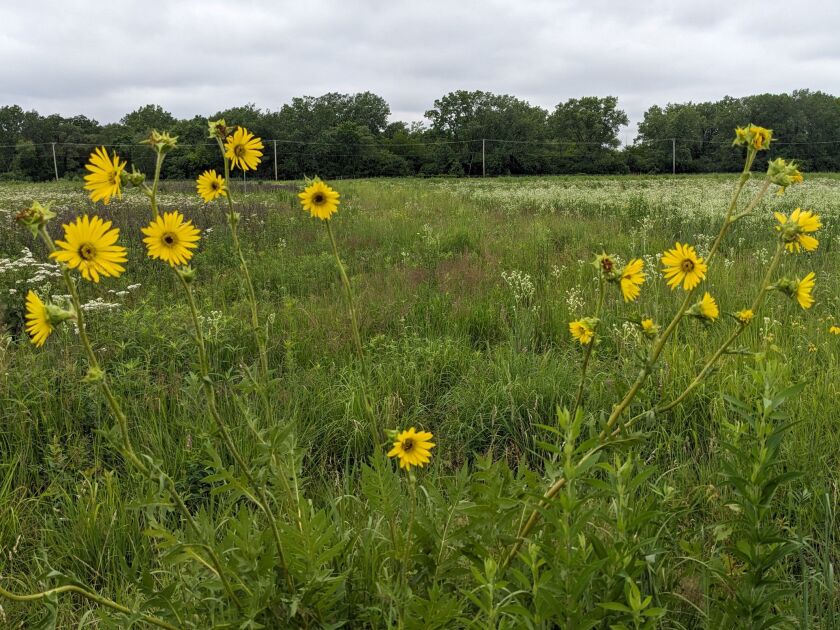A few blackberries ripened inside the gap in fencing at the dead end of Whipple Street, running north off 159th between Popeyes and McDonald’s. To the east came the rumble of the Tri-State Tollway.
Welcome to Gensburg-Markham Prairie.
For years, Joel Greenberg, author of “A Natural History of the Chicago Region,” raved about Markham Prairie, largest of five high quality and rare prairie remnants comprising the Indian Boundary Prairies located within Markham and Harvey.
The Nature Conservancy of Illinois and Northeastern Illinois University manage/own it. Long ago, the Markham Prairie was grazed but never plowed. It’s a dedicated Illinois Nature Preserve and a National Natural Landmark.
I never set foot on it until Thursday. Should have listened to Greenberg years ago.
I have a mid-summer tradition of wandering a prairie, generally Midewin National Tallgrass Prairie. This year, I decided to expand my horizons with Markham.
It’s different than MNTP.
I had barely started rambling when the calls of frogs I couldn’t identify mixed with the background rumble of Tri-State traffic. I texted a recording to Allison Sacerdote-Velat, curator of herpetology at Chicago Academy of Sciences/Peggy Notebaert Nature Museum, who almost immediately texted back.
“Those are boreal chorus frogs,” she explained. “Our calling frog survey monitors have been picking up a lot of observations of late-season calling and secondary calling bouts following the large rain events that refilled a lot of dried wetlands in the last few weeks.
She texted a copy of chorus frogs and American toads calling on July 3 and gave this context, “The chorus frogs start as early as late February and typically continue calling until mid-May, with their peak activity in March and April.”
When I played the recording, I swear the frogs were shocked.
A rabbit hopped off as I started, the only mammal I saw. Monarchs almost immediately flitted around, making up for a personal lack of seeing them this year. Good stands of flowering common milkweed as well as swamp milkweed probably helped. Butterflies and moths I couldn’t identify flew around, as did multiple types of bees.
Plants that I noted almost immediately were phlox, wild bergamot, rattlesnake master and black-eyed Susans (a personal favorite).
Beside blackberries, I also saw found chokeberry. But I did not find any huckleberry, one of the significant sand prairie plants—along with colic root, yellow-eyed grass and screwstem—found there. Nor did I find any of the rare plant species—grape fern, sundrop, narrow-leaved sundew and grass pink orchid—found there.
Greenberg visited earlier this week with an Orthodox birding group, then emailed that the dominant flower flowering was wild quinine. It certainly was, forming a sea of white in some areas.
I found a few blooming blazing star, they’re just starting to bloom. Compass plants and coneflowers bordered on gaudy in spots, lesser shows came from rosinweed and hoary vervain.
Other plants Greenberg thought I might notice, but I did not, were Culver’s root, flowering spurge, butterfly weed, Illinois tick-trefoil, prairie Indian plantain (I probably overlooked it) and false white indigo.
The Illinois Department of Natural Resources describes Markham Prairie as “consisting of wet-mesic and mesic prairie, dry mesic and mesic sand prairie and sedge meadow communities representative of the Chicago Lake Plain Section of the Northeastern Morainal Natural Division. The Chicago Lake Plain was formed as glacial Lake Chicago receded at the end of the Wisconsinan glaciation. As the water receded, it left behind deposits of clay and sand. The wetlands on the preserve are underlain by clay while the drier sites are underlain by sand. An old beach ridge formed by the ancient lake runs southeast to northeast through the preserve, and is responsible for the difference in relief over the preserve. . . . [It] is an unusual example of sandy loam prairie; it combines the characteristics of the black silt loam prairies with the true sand prairies.”
It certainly holds a variety of life. On the north end, I heard bullfrogs.
Common yellowthroats and red-winged blackbirds were the most common birds. Others included eastern kingbird, a swallow I couldn’t ID, northern flicker, indigo bunting, cardinal, starling, song sparrow, robin, goldfinch, grackle and cedar waxwing.
House wren and chickadee, back at the parking lot, completed my birds.
It was time.
Information is at dnr.illinois.gov/inpc/area.area2cookgensburg-markhamprairie.html.









